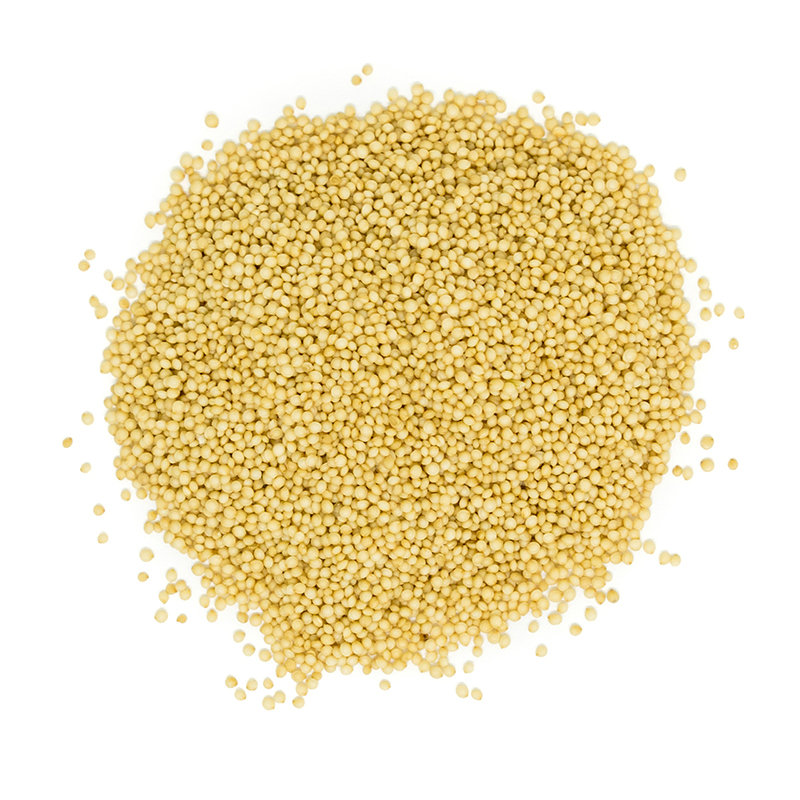-
Description
Amaranth is a fast-growing, drought-resistant plant that produces a small seeded grain in a sorghum-like head. The amaranth seed is remarkably tiny; it takes approximately 32 amaranth seeds to equal the weight of 1 wheat kernel. Since the grain is minute size, it possesses highly concentrated nutrition, due to the fact that much of the seed is constituted of the nutrient-rich outer layer.
Like Quinoa, Amaranth is not technically a grain but is the seed of the Amaranth plant. One plant can produce up to 60,000 seeds. Amaranth doesn’t contain any gluten, which makes it a great choice for people who are celiac or gluten intolerant and an excellent way to boost the nutritional power of gluten-free recipes. Amaranth contains calcium, magnesium, potassium, phosphorus, and iron. One cup of uncooked amaranth has 31% of the RDA for calcium, 14% for vitamin C, and a whopping 82% for iron.
-
Directions
Boil 1 cup amaranth grain in 2 1/2 cups water or stock. Cook for 18-20 minutes, or until grain is tender. Overcooking can cause amaranth to become sticky.
Instant Pot:
This is another quick Instant Pot recipe, it can cook within 5 minutes! Place 1 cup Amaranth, 2 cups of water or stock, 1 tablespoon oil/butter/ghee/coconut oil, and 1 teaspoon salt into the stainless steel insert of your Instant Pot. Set your Instant Pot to Manual on high pressure for 5 minutes.
Let out pressure with the quick release method and stir. Reduce any residual water by simmering and letting it steam off. You can also add butter or oil at this point to deepen the flavour of the amaranth. -
Uses
Amaranth grain can be cooked and eaten as a cereal or side dish alone or with other whole grains. It can also be popped like popcorn, expanding to about 10 times the original volume. The popped amaranth has a toasted, nutty flavour, and can be used in a variety of ways such as in confections bound with syrup, molasses or honey, and in high-energy granola bars.
-
Storage
When stored in a cool (preferably less than 60˚F) and dry location (less than 65% humidity), shelf life is approximately 1 year.
-
Nutrition
Nutrition Facts Per 1/4 cup (45 g) Amount % Daily Value Calories 170 - Fat 3 g 4% Saturated Fat 0.5 g - + Trans Fat 0 g 10% Carbohydrate 29 g - Fibre 3 g 11% Sugars 1 g 1% Sugar Alcohol - - Protein 6 g - Cholesterol 0 mg - Sodium 0 mg 0% Potassium 225 mg 5% Calcium 75 mg 6% Iron 3.5 mg 19% -
Allergens
Attention: May contain other seeds or small stones.
-
Recipes & Posts
| SKU | Unit Size |
|---|---|
| 23282 | 12 x 400 g |
| 23284 | 5 kg BULK |
| 23285 | 11.3 kg RM |
-
Description
-
Directions
-
Uses
-
Nutrition
-
Storage
-
Allergens
-
Recipes & Posts
-
Amaranth is a fast-growing, drought-resistant plant that produces a small seeded grain in a sorghum-like head. The amaranth seed is remarkably tiny; it takes approximately 32 amaranth seeds to equal the weight of 1 wheat kernel. Since the grain is minute size, it possesses highly concentrated nutrition, due to the fact that much of the seed is constituted of the nutrient-rich outer layer.
Like Quinoa, Amaranth is not technically a grain but is the seed of the Amaranth plant. One plant can produce up to 60,000 seeds. Amaranth doesn’t contain any gluten, which makes it a great choice for people who are celiac or gluten intolerant and an excellent way to boost the nutritional power of gluten-free recipes. Amaranth contains calcium, magnesium, potassium, phosphorus, and iron. One cup of uncooked amaranth has 31% of the RDA for calcium, 14% for vitamin C, and a whopping 82% for iron.
-
Boil 1 cup amaranth grain in 2 1/2 cups water or stock. Cook for 18-20 minutes, or until grain is tender. Overcooking can cause amaranth to become sticky.
Instant Pot:
This is another quick Instant Pot recipe, it can cook within 5 minutes! Place 1 cup Amaranth, 2 cups of water or stock, 1 tablespoon oil/butter/ghee/coconut oil, and 1 teaspoon salt into the stainless steel insert of your Instant Pot. Set your Instant Pot to Manual on high pressure for 5 minutes.
Let out pressure with the quick release method and stir. Reduce any residual water by simmering and letting it steam off. You can also add butter or oil at this point to deepen the flavour of the amaranth. -
Amaranth grain can be cooked and eaten as a cereal or side dish alone or with other whole grains. It can also be popped like popcorn, expanding to about 10 times the original volume. The popped amaranth has a toasted, nutty flavour, and can be used in a variety of ways such as in confections bound with syrup, molasses or honey, and in high-energy granola bars.
-
Nutrition Facts Per 1/4 cup (45 g) Amount % Daily Value Calories 170 - Fat 3 g 4% Saturated Fat 0.5 g - + Trans Fat 0 g 10% Carbohydrate 29 g - Fibre 3 g 11% Sugars 1 g 1% Sugar Alcohol - - Protein 6 g - Cholesterol 0 mg - Sodium 0 mg 0% Potassium 225 mg 5% Calcium 75 mg 6% Iron 3.5 mg 19% -
When stored in a cool (preferably less than 60˚F) and dry location (less than 65% humidity), shelf life is approximately 1 year.
-
Attention: May contain other seeds or small stones.
